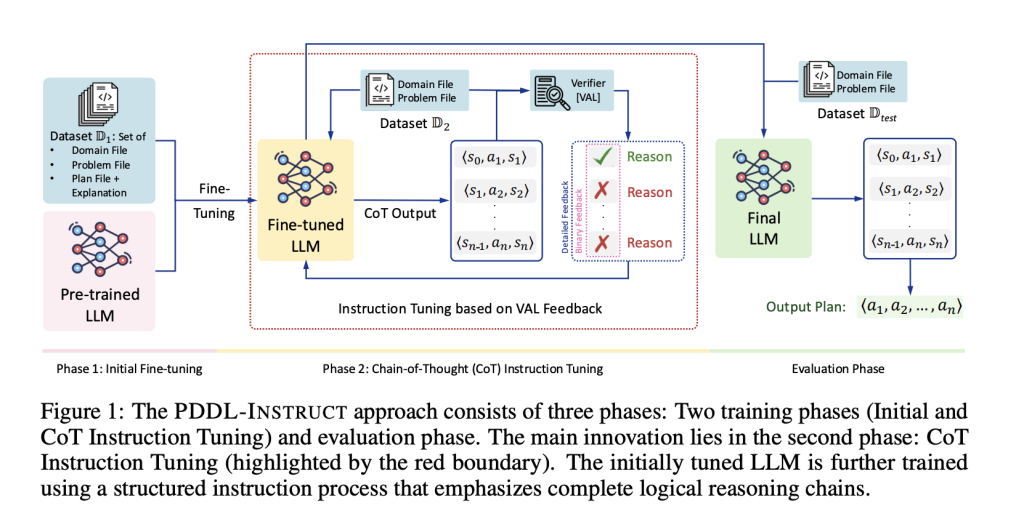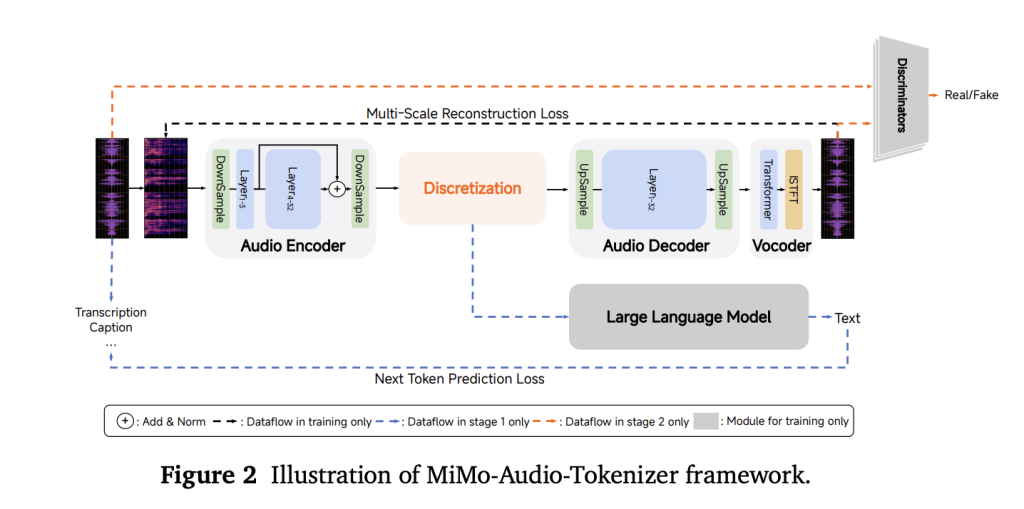Xiaomi’s MiMo team released MiMo-Audio, a 7-billion-parameter audio-language model that runs a single next-token objective over interleaved text and discretized speech, scaling pretraining beyond 100 million hours of audio. What’s actually new? Instead of relying on task-specific heads or lossy acoustic tokens, MiMo-Audio uses a bespoke RVQ (residual vector quantization) tokenizer that targets both semantic fidelity and high-quality reconstruction. The tokenizer runs at 25 Hz and outputs 8 RVQ layers (≈200 tokens/s), giving the LM access to “lossless” speech features it can model autoregressively alongside text. Architecture: patch encoder → 7B LLM → patch decoder To handle the audio/text rate mismatch, the system packs four timesteps per patch for LM consumption (downsampling 25 Hz → 6.25 Hz), then reconstructs full-rate RVQ streams with a causal patch decoder. A delayed multi-layer RVQ generation scheme staggers predictions per codebook to stabilize synthesis and respect inter-layer dependencies. All three parts—patch encoder, MiMo-7B backbone, and patch decoder—are trained under a single next-token objective. https://xiaomimimo.github.io/MiMo-Audio-Demo/ Scale is the algorithm Training proceeds in two big phases: (1) an “understanding” stage that optimizes text-token loss over interleaved speech-text corpora, and (2) a joint “understanding + generation” stage that turns on audio losses for speech continuation, S2T/T2S tasks, and instruction-style data. The report emphasizes a compute/data threshold where few-shot behavior appears to “switch on,” echoing emergence curves seen in large text-only LMs. Benchmarks: speech intelligence and general audio MiMo-Audio is evaluated on speech-reasoning suites (e.g., SpeechMMLU) and broad audio understanding benchmarks (e.g., MMAU), reporting strong scores across speech, sound, and music and a reduced “modality gap” between text-only and speech-in/speech-out settings. Xiaomi also releases MiMo-Audio-Eval, a public toolkit to reproduce these results. Listen-and-respond demos (speech continuation, voice/emotion conversion, denoising, and speech translation) are available online. https://xiaomimimo.github.io/MiMo-Audio-Demo/ Why this is important? The approach is intentionally simple—no multi-head task tower, no bespoke ASR/TTS objectives at pretraining time—just GPT-style next-token prediction over lossless audio tokens plus text. The key engineering ideas are (i) a tokenizer the LM can actually use without throwing away prosody and speaker identity; (ii) patchification to keep sequence lengths manageable; and (iii) delayed RVQ decoding to preserve quality at generation time. For teams building spoken agents, those design choices translate into few-shot speech-to-speech editing and robust speech continuation with minimal task-specific finetuning. 6 Technical Takeaways: High-Fidelity TokenizationMiMo-Audio uses a custom RVQ tokenizer operating at 25 Hz with 8 active codebooks, ensuring speech tokens preserve prosody, timbre, and speaker identity while keeping them LM-friendly. Patchified Sequence ModelingThe model reduces sequence length by grouping 4 timesteps into one patch (25 Hz → 6.25 Hz), letting the 7B LLM handle long speech efficiently without discarding detail. Unified Next-Token ObjectiveRather than separate heads for ASR, TTS, or dialogue, MiMo-Audio trains under a single next-token prediction loss across interleaved text and audio, simplifying architecture while supporting multi-task generalization. Emergent Few-Shot AbilitiesFew-shot behaviors such as speech continuation, voice conversion, emotion transfer, and speech translation emerge once training surpasses a large-scale data threshold (~100M hours, trillions of tokens). Benchmark LeadershipMiMo-Audio sets state-of-the-art scores on SpeechMMLU (S2S 69.1, T2S 71.5) and MMAU (66.0 overall), while minimizing the text-to-speech modality gap to just 3.4 points. Open Ecosystem ReleaseXiaomi provides the tokenizer, 7B checkpoints (base and instruct), MiMo-Audio-Eval toolkit, and public demos, enabling researchers and developers to test and extend speech-to-speech intelligence in open-source pipelines. Summary MiMo-Audio demonstrates that high-fidelity, RVQ-based “lossless” tokenization combined with patchified next-token pretraining at scale is sufficient to unlock few-shot speech intelligence without task-specific heads. The 7B stack—tokenizer → patch encoder → LLM → patch decoder—bridges the audio/text rate gap (25→6.25 Hz) and preserves prosody and speaker identity via delayed multi-layer RVQ decoding. Empirically, the model narrows the textspeech modality gap, generalizes across speech/sound/music benchmarks, and supports in-context S2S editing and continuation. Check out the Paper, Technical details and GitHub Page. Feel free to check out our GitHub Page for Tutorials, Codes and Notebooks. Also, feel free to follow us on Twitter and don’t forget to join our 100k+ ML SubReddit and Subscribe to our Newsletter. The post Xiaomi Released MiMo-Audio, a 7B Speech Language Model Trained on 100M+ Hours with High-Fidelity Discrete Tokens appeared first on MarkTechPost.



